
Tucmuc
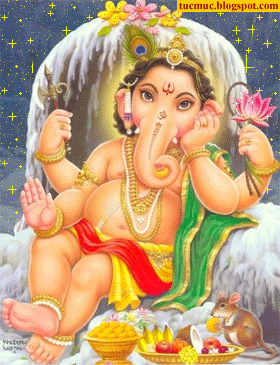
Tucmuc

Tucmuc
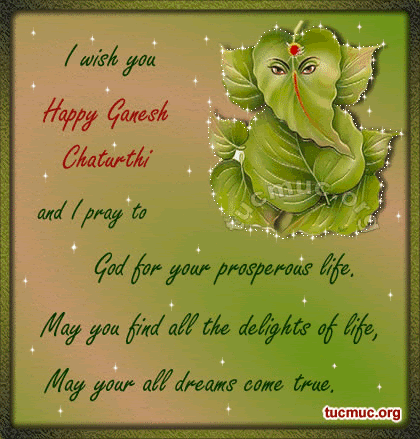
Tucmuc

Tucmuc

Tucmuc

Tucmuc
Lord Ganesh, que também é conhecido por vários outros nomes, tais como Ganapathi, Vinaayaka ou Vighneswara, é o Deus que nos ajuda a superar obstáculos na vida. Ele é filho de Shiva e Parvati mãe. Todo ritual ou cerimônia ou projeto começa com a adoração ao Senhor Ganesha
Lord Ganesh, who is also known by various other names such as Ganapathi, Vinaayaka or Vighneswara, is the God who helps us overcome obstacles in life. He is the son of Lord Shiva and Mother Parvathi. Every rite or ceremony or project starts with the worship of Lord Ganesha


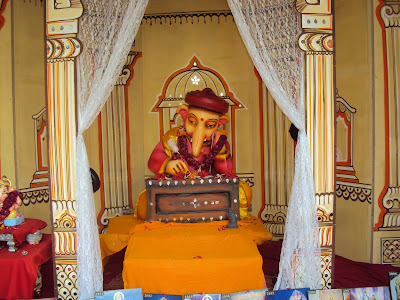






Ganesh Puja
ARTISTs: Rajendra Prasad Kimothi

This is a video which clearly shows the Ganesh Vissarjan or immersion of the Ganpati idol. It is a very holy ritual and is proudly celebrated in India and especially Mumbai.
Este é um vídeo que mostra claramente a Vissarjan Ganesh ou imersão do ídolo Ganpati. É um ritual muito santo e é celebrada com orgulho na Índia e, especialmente, Mumbai.
BIOGRAFIA
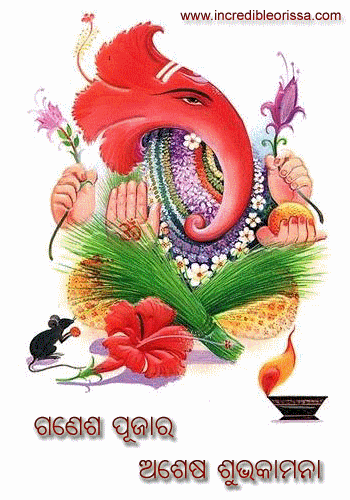
incredibleorissa.com
Sri Ganesh Mahotsav
Sri Ganesh Mahotsav
Ganpati festival (Ganesh Mahotsav) Sms, Wallpapers e Bhajans 2011
Ganesh Chaturthi -
Data: - 01 de setembro de 2011
O quarto dia do mês Bhadrapad é um dia específico para Ganesh. É muito enfaticamente afirmado por Dnyaneshwar em Maharashtra, onde a importância e disseminação de adoração Ganesh na Bhadrapad de Mahina (agosto-setembro) é o maior, o quarto brilhante do festival lunar.This é comemorado por 10 dias a partir Ganesh Chaturthi - nascimento -data-to Anant Chaturdashi - o último dia 10 de sua imersão. Todo mundo adora esta divindade com sua curva tronco barriguinha, e grandes orelhas plana. Ele é o protetor benevolente dos inocentes, mas o destruidor implacável do mal. Sua montagem é um rato.
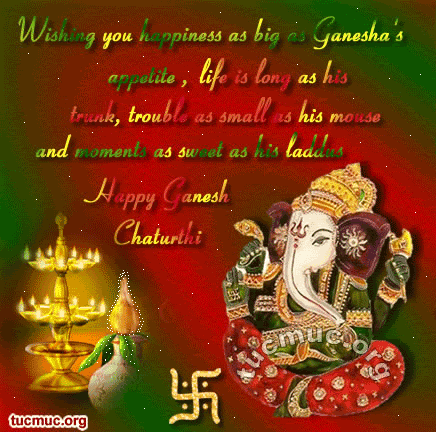
Tucmuc
Em vários estados da Índia, mas especialmente em Maharashtra ídolos de barro de Ganesh em tamanhos variados são feitos e vendidos. Os ídolos são comprados e levados para casa no dia anterior para Ganesh Chaturthi, que é o dia da Hartalik quando mulheres guardam rápido e invocar as bênçãos da deusa Parvati, que é a mãe de Ganesh.
Nas ruas e adoração comunidade estabelecimentos comerciais é oferecido a um tamanho real ou mesmo uma imagem maior, instalado em uma plataforma erguida. Este Senhor Ganesh gosta muito de doces e, portanto, khir, panchamrit, frutas e doces e, especialmente, modaks são colocados diante dele como "Naivedya" ou "Bhog". Após o ritual adorar este "Bhog" é distribuído como "Prasad". O mais popular e colorido festival Ganesh é uma ocasião saudáveis para as orações rituais de adoração, celebrações e hospitalidade. Significa, também, boa vontade da alegria, e caseiros doces, lanches picante e uma variedade de preparations.One delicioso dos pratos doces preparados durante este festival é Modak.
No dia de imersão, que pode ser em 3, dia 5 ou 7 10 após a realização de "Puja", o ídolo é retirado em uma procissão de pessoas que dançam e cantam. No dia 10 - o dia Chaturdashi Anant as frentes de mar são embalados com afluência em massa da humanidade como os ídolos de Ganesh são realizadas para seu descanso aquosa entre gritos de "Ganapati Bappa Moriya, Pudhachya varshi lavkar ya" (Return início do próximo ano, Oh Vitorioso Senhor Ganesh).
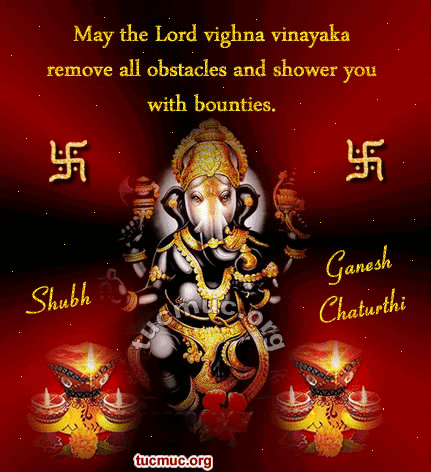
Tucmuc
O R I G I N O F G A N E S T U H A S V: -
Aconteceu que um sardar de Peshwa chamado Nanasaheb Khajgiwale em 1892 visitou o palácio de Gwalior, onde ele se deparou com Ganesh Utsav. Pessoas de todas as esferas da vida participaram neste Utsav. Vendo isto, ficou encantado Nanasaheb e decidiu iniciar o mesmo tipo de festival de Pune, a capital do Peshwa. Assim, em 1896 Shri Khajgiwale, Shri Shri Ghotawadekar e Bhau Rangari arranjou um Sarvajanik PublicGanesh Utsav e no mesmo ano, Ganesh ritual de imersão também foi iniciado.
No ano seguinte ou seja 1897, o número de mandals Ganesh aumentou de forma alarmante, ea questão de cuja Ganpati será o primeiro em cavalgada foi muito debatido. Neste momento crucial, Shri Lokmanya Tilak e Shri Annasaheb Patwardhan foram chamados para resolver o problema. Eles deram preferência aos Jijamata Prasthapit Kasaba Ganapati Ganesh Utsav mandal. Posteriormente, as pessoas começaram a celebrar Ganesh Utsav em grande escala.
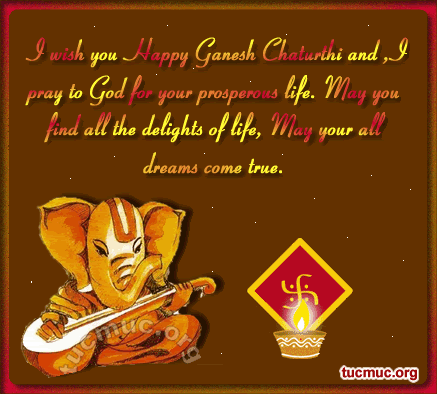
Tucmuc
Ganpati Festival em Pune: -
O Festival de Ganesh foi iniciada por Lokmanya Bal Gangadhar Tilak, o combatente da liberdade da Índia e fundador da "Kesari". Ele insistiu que o festival de Lord Ganesha, o deus com cabeça de elefante hindus, deve ser adorado com grande entusiasmo, a fim de trazer paz e harmonia comunitária na Índia. Ele começou o festival de Pune no ano de 1893.
Ganpati Festival em Mumbai: -
Keshavji Naik chawl (Girgaon) foi o pioneiro em iniciar o Utsav Ganesh em Bombaim com a figura sendo cerca de 2500 no momento, assim que significa a crescente popularidade deste festival. É comemorado com grande fervor e pompa em Mumbai-região Sul de idade e região Central.

Tucmuc
Ganpati festival ( Ganesh Mahotsav) Sms , Wallpapers and Bhajans 2011
Ganesh Chaturthi -
Date : - 1 September 2011
The fourth day of Bhadrapad month is a specific day for Ganesh. It is very emphatically asserted by Dnyaneshwar in Maharashtra, where the importance and spread of Ganesh worship in the of Bhadrapad Mahina (August – September ) is the greatest, the bright fourth of lunar.This festival is celebrated for 10 days from Ganesh Chaturthi - birth -date-to Anant Chaturdashi - the final 10th day of his immersion. Everyone loves this deity with his curving trunk, potbelly and big flat ears. He is the benevolent protector of the innocent, yet the ruthless destroyer of evil. His mount is a rat.
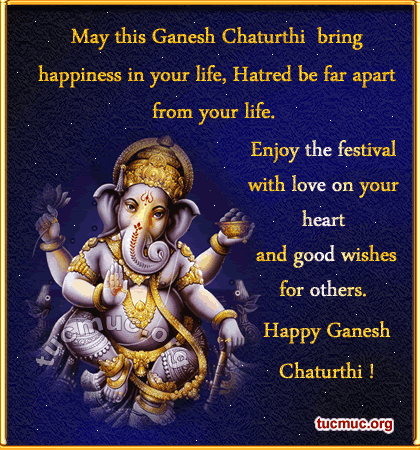
Tucmuc
In several states of India, but especially in Maharashtra clay idols of Ganesh in varying sizes are made and sold. The idols are purchased and brought home the day previous to Ganesh Chaturthi, which is the day of Hartalik when women keep fast and invoke the blessings of goddess Parvati, who is Ganesh's mother.
In streets and commercial establishments community worship is offered to a life-size or even a bigger image, installed on an erected platform. This Lord Ganesh is very fond of sweets and hence khir, panchamrit, fruits and sweets and specially modaks are placed before him as "Naivedya" or "Bhog". After the ritual worship this "Bhog" is distributed as "Prasad".The most popular and colourful Ganesh festival is a wholesome occasion for ritual worship prayers, celebrations and hospitality. It also means cheer, goodwill and homemade sweets, spicy snacks and a variety of delicious preparations.One of the sweet dishes prepared during this festival is Modak .

Tucmuc
On the day of immersion, which is either on 3rd, 5th, 7th or 10th day after performing of "Puja", the idol is taken out in a procession by people who dance and sing. On the 10th day - the Anant Chaturdashi day the sea fronts are packed with surging mass of humanity as the idols of Ganesh are carried towards their watery rest among shouts of "Ganapati Bappa Moriya, Pudhachya varshi lavkar ya" (Return early next year, Oh Victorious Lord Ganesh).
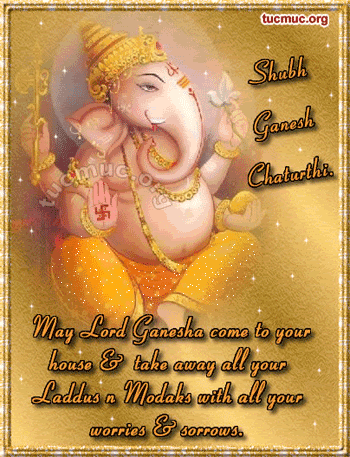
Tucmuc
O R I G I N O F G A N E S H U T S A V : -
It so happened that one sardar of Peshwa named Nanasaheb Khajgiwale in 1892 visited the palace of Gwalior, where he came across Ganesh Utsav. People from all walks of life participated in this utsav. Seeing this, Nanasaheb got delighted and decided to start the same kind of festival at Pune, the capital of Peshwa. Accordingly, in 1896 Shri Khajgiwale, Shri Ghotawadekar and Shri Bhau Rangari arranged a Sarvajanik PublicGanesh Utsav and in the same year, Ganesh immersion ritual was also started.
In the next year i.e. 1897, the number of Ganesh mandals increased alarmingly, and the question of whose Ganpati will be the first in cavalcade was hotly debated. At this crucial time, Shri Lokmanya Tilak and Shri Annasaheb Patwardhan were called to resolve the issue. They gave first preference to Jijamata Prasthapit Kasaba Ganapati Ganesh Utsav mandal. Thereafter, people started celebrating Ganesh Utsav on a large scale.
Ganpati Festival in Pune :-
The Ganesh Festival was pioneered by Lokmanya Bal Gangadhar Tilak, the Indian freedom fighter and founder of "Kesari". He insisted that the festival of Lord Ganesha, the Elephant headed God of Hindus, should be worshipped with great enthusiasm, in order to bring peace and communal harmony in India. He started this festival in Pune in the year 1893.
Ganpati Festival in Mumbai : -
Keshavji Naik Chawl (Girgaon) was the pioneer in starting the Ganesh Utsav in Mumbai with the figure being around 2500 at present thereby signifying the ever increasing popularity of this festival. It is celebrated with great fervor and pomp in old Mumbai- Southern region and Central region.
Ganesh Chaturthi
From Wikipedia, the free encyclopedia
Ganesh Chaturthi
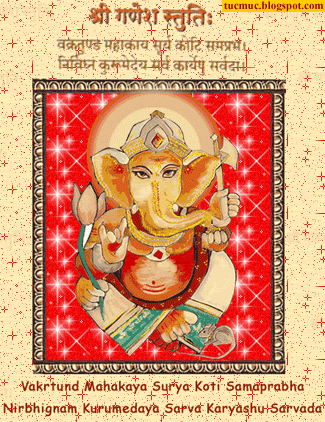
Tucmuc
Lalbaughcha Raja (2007) Ganesha image worshipped in Mumbai, Maharashtra. It is the most visited Ganesha Mandal in Mumbai.[1]
Observed by Hindus
Type Religious, folk
Begins Bhadrapada shukla chaturthi
Ends Anant Chaturdashi
Date August/September
2011 date 1 September
2012 date 19 September
Celebrations Setting up Pandals, street processions and idol immersion
Ganesha Chaturthi (Marathi: गणेश चतुर्थी, Hindi: गणेश चतुर्थी, Tamil: விநாயகர் சதுர்த்தி Kannada: ಗಣೇಶ ಚತುರ್ಥೀ,Telugu: వినాయక చవితి), also known as Vinayaka Chaturthi is the Hindu festival of Ganesha also called Vinayagar in Tamil Nadu, the son of Shiva and Parvati, who is believed to bestow his presence on earth for all his devotees in the duration of this festival. It is the day Shiva declared his son Ganesha as superior to all the gods. Ganesha is widely worshipped as the god of wisdom, prosperity and good fortune and traditionally invoked at the beginning of any new venture or at the start of travel.
The festival is observed in the Hindu calendar month of Bhaadrapada, starting on the shukla chaturthi (fourth day of the waxing moon period). The date usually falls between 20 August and 15 September. The festival lasts for 10 days, ending on Anant Chaturdashi (fourteenth day of the waxing moon period).
While celebrated all over India, it is most elaborate in Andhra Pradesh, Maharashtra, Karnataka and Goa. Outside India, it is celebrated widely in Nepal and by Hindus in the United States, Canada, Singapore and Fiji.
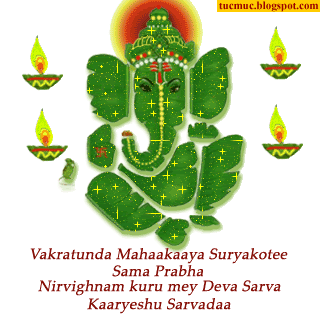
Tucmuc
Contents [hide]
1 Legend
2 Date
3 Celebration, rituals and tradition
3.1 In India
3.2 Outside India
4 Lokmanya Bal Gangadhar Tilak's Revival efforts
5 Environmental impact
6 Celebrations (past and future)
7 Gallery
8 See also
9 References
10 External links
[edit]Legend
Traditional stories tell that Lord Ganesha (or Ganapati) (the names mean "Lord isha or pati of Shiva's hosts gana) was created by goddess Parvati, consort of Lord Shiva. Parvati created Ganesha out of sandalwood paste that she used for her bath and breathed life into the figure. She then set him to stand guard at her door while she bathed. However, while she bathed, Lord Shiva returned and as Ganesha didn't know him, he didn't allow him to enter. Lord Shiva became enraged and severed the head of the child and entered his house. After realizing that he had beheaded his own son, Lord Shiva fixed the head of an elephant (in some versions, Airavata, the vehicle of the god Indra) in place of Ganesha's head. In this way, Lord Ganesha came to be depicted as the elephant-headed God.
[edit]Date
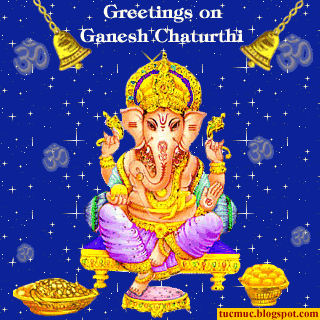
Tucmuc
The festival is observed in the Hindu calendar month of Bhaadrapada, starting on the shukla chaturthi (fourth day of the waxing moon period). The date usually falls between 20 August and 15 September. The festival lasts for 10 or 12 days, ending on Anant Chaturdashi. This festival is observed in the lunar month of bhadrapada shukla paksha chathurthi madhyahana vyapini purvaviddha. If Chaturthi prevails on both days, the first day should be observed. Even if chaturthi prevails for the complete duration of madhyahana on the second day, if it prevails on the previous day's madhyahana period even for one ghatika (24 minutes), the previous day should be observed.[2]
[edit]Celebration, rituals and tradition
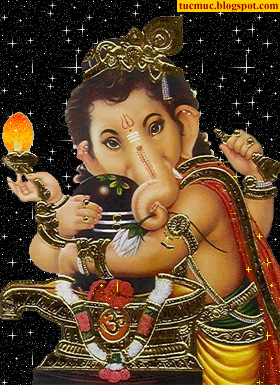
Tucmuc
[edit]In India
Large idols such as this are seen all over Mumbai during the festival
Two to three months prior to Ganesh Chaturthi, artistic clay models of Lord Ganesha are made for sale by specially skilled artisans. They are beautifully decorated & depict Lord Ganesh in various poses. The size of these statues may vary from 3/4 of an inch to over 25 feet.
Ganesh Chaturthi starts with the installation of these Ganesh statues in colorfully decorated homes and specially erected temporary structures mandapas (pandals) in every locality. The pandals are erected by the people or a specific society or locality or group by collecting monetary contributions. The pandals are decorated specially for the festival, either by using decorative items like flower garlands, lights, etc. or are theme based decorations, which depict religious themes or current events.
The priest, usually clad in red or white dhoti and uttariyam(Shawl), then symbolically invokes life into the statue by chanting mantras. This ritual is the Pranapratishhtha. After this the ritual called as Shhodashopachara (16 ways of paying tribute) follows. Coconut, jaggery, 21 modakas, 21 durva (trefoil) blades of grass and red flowers are offered. The statue is anointed with red unguent, typically made of Kumkum & Sandalwood paste . Throughout the ceremony, Vedic hymns from the Rig Veda, the Ganapati Atharva Shirsha Upanishad, and the Ganesha stotra from the Narada Purana are chanted.

Tucmuc
Ganesh Visarjan in Mumbai
Vinayaka Nimarjanam in Hyderabad Andhra Pradesh
Ganesha is worshiped for 10 days from Bhadrapada Shudha Chaturthi to the Ananta Chaturdashi. On the 11th day, the statue is taken through the streets in a procession accompanied with dancing, singing, and fanfare to be immersed in a river or the sea symbolizing a ritual see-off of the Lord in his journey towards his abode in Kailash while taking away with him the misfortunes of his devotees, this is the ritual known as Ganesh Visarjan in Marathi and Vinayaka Nimarjana or Vinayaka Nimajjanam in Telugu. At individual homes the Visarjan/Nimajjanam is also done on 3rd, 5th or 7th day as per the family tradition. All join in this final procession shouting "Ganapati Bappa Morya, Pudhachya Varshi Laukar ya" (O lord Ganesha, come again early next year) in Maharastra and "Ganesh Maha Raj ku, Jai" (lord Ganesha, victory is yours) in Andhra Pradesh. After the final offering of coconuts, flowers and camphor is made, people carry the idols to the river to immerse it.
The main sweet dish during the festival is the modak (modak in Marathi, modakam in Telugu, modaka in Kannada and modagam in Tamil). A modak is a dumpling made from rice flour/wheat flour with a stuffing of fresh or dry-grated coconut, jaggery, dry fruits and some other condiments. It is either steam-cooked or fried. Another popular sweet dish is the karanji (karjikai in Kannada) which is similar to the modak in composition and taste but has a semicircular shape.
In Andhra, Kudumu(Rice flour dumplings stuffed with coconut and jaggery mixture),Vundrallu(steamed coarsely grounded rice flour balls), Panakam (jaggery, black pepper and cardamom flavored drink), Vadapappu(soaked and moong lentils), Chalividi (cooked rice flour and jaggery mixture) etc.. are offered to Ganesha along with Modakams. These offerings to god are called Naivedyam in Telugu.
Public celebrations of the festival are hugely popular, with local communities (mandalas) vying with each other to put up the biggest statue & the best pandal. The festival is also the time for cultural activities like singing and theater performances, orchestra and community activities like free medical checkup, blood donation camps, charity for the poor, etc.
Today, the Ganesh Festival is not only a popular festival, it has become a very critical and important economic activity for Mumbai, Hyderabad, Vishakhapatnam, Bangalore and Chennai . Many artists, industries, and businesses survive on this mega-event. Ganesh Festival also provides a stage for budding artists to present their art to the public. In Maharashtra, not only Hindus but many other religions also participate in the celibration of Ganesha festival like Muslims, Jains, Christian and others.
This festival has managed to re-establish the unity among the Indians during British Era.
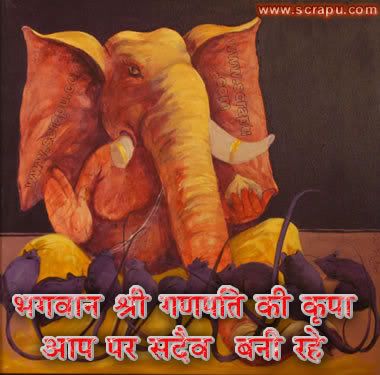
Tucmuc
[edit]Outside India
Dancers on the streets of Paris during the 2009 Ganesh Chaturthi festival
Ganesh Chaturthi is celebrated in the UK by the migrant Hindu population as well as the large number of Indians residing there. The Hindu culture and Heritage Society, UK - a Southall based organisation celebrated Ganesh Chaturthi for the first time in London in 2005 at The Vishwa Hindu Temple. The Idol was immersed in the river Thames at Putney Pier. Another celebration organised by an Gujarati group has been celebrated in the Southend on Sea which attracts over 18000 devotees.[3] Annual celebrations also take place on the River Mersey at Liverpool.[4][5]
The festival is similarly celebrated in many locations across the world. The Hindu Swayamsevak Sangh USA, an organisation of Hindus based in the US organises many such events to mark the various Hindu festivals.
In USA, Ganesh Chaturthi is celebrated by various associations of Telugu speaking people. (Telugu Association of North America, Bay Area Telugu Association and Balaji Temples acrosss USA)
In Canada, Ganesh Chaturthi is celebrated by various associations of Marathi speaking people. (MBM in Toronto, MSBC in Vancouver etc.).
Celebration of Ganesh Chaturthi in Mauritius dates back to 1896. The first Ganesh Chaturthi Puja was held in the 7 Cascades Valley next to Henrietta village by the Bhiwajee family who is still celebrating this pious festival for more than a century.
Over the years the festival gained such popularity on the island that Mauritian government has attributed a public holiday for that day.
[edit]Lokmanya Bal Gangadhar Tilak's Revival efforts

Tucmuc
Lokmanya Bal Gangadhar Tilak
It is not known when and how Ganesh Chaturthi was first celebrated. But according to the historian Shri Rajwade, the earliest Ganesh Chaturthi celebrations can be traced back to the times of the reigns of dynasties as Satavahana,[citation needed] Rashtrakuta[citation needed] and Chalukya.[citation needed] Historical records reveal that Ganesh Chaturthi celebrations were initiated in Maharashtra by Chatrapati Shivaji Maharaja, a great Maratha ruler, to promote culture and nationalism. And it had continued ever since. There are also references in history to similar celebrations during Peshwa times. It is believed that Lord Ganapati was the family deity of the Peshwas. After the end of Peshwa rule, Ganesh Chaturthi remained a family affair in Maharashtra from the period of 1818 to 1892.
In 1893, Indian freedom fighter and social reformer Lokmanya Tilak transformed the annual domestic festival into a large, well-organized public event.[6]
Tilak recognized the wide appeal of the deity Ganesh as "the god for everybody",[7][8] and popularized Ganesh Chaturthi as a national festival in order "to bridge the gap between Brahmins and 'non-Brahmins' and find a context in which to build a new grassroots unity between them", and generate nationalistic fervor among people in Maharashtra against the British colonial rule.[9][10]
Tilak encouraged installation of large public images of Ganesh in pavilions, and also established the practice of submerging in rivers, sea, or other pools of water all public images of the deity on the tenth day after Ganesh Chaturthi.[11]
Under Tilak's encouragement, the festival facilitated community participation and involvement in the form of intellectual discourses, poetry recitals, performances of plays, musical concerts, and folk dances. It served as a meeting ground for people of all castes and communities in times when, in order to exercise control over the population, the British discouraged social and political gatherings.
[edit]Environmental impact
Lake contaminated with Plaster of Paris Ganesha idols
The most serious impact of the Ganesh festival on the natural environment is due to the immersion of icons made of Plaster of Paris into lakes, rivers and the sea. Traditionally, the Ganesh icon was sculpted out of earth taken from nearby one’s home. After worshipping the divinity in this earth icon, it was returned back to the Earth by immersing it in a nearby water body. This cycle represented the cycle of creation and dissolution in Nature.
However, as the production of Ganesh icons on a commercial basis grew, the earthen or natural clay (shaadu maati in Marathi) was replaced by Plaster of Paris. Plaster is a man made material, easier to mould, lighter and less expensive than clay. However, plaster takes much longer to dissolve and in the process of dissolution releases toxic elements into the water body. The chemical paints used to adorn these plaster icons themselves contain heavy metals like mercury and cadmium.
On the final day of the Ganesh festival thousands of plaster icons are immersed into water bodies by devotees. These increase the level of acidity in the water and the content of heavy metals.[12] Several non governmental and governmental bodies have been addressing this issue. Amongst the solutions proposed by various groups some are as follows:
Return to the traditional use of natural clay icons and immerse the icon in a bucket of water at home.[13]
Use of a permanent icon made of stone and brass, used every year and a symbolic immersion only.
Recycling of plaster icons to repaint them and use them again the following year.
Ban on the immersion of plaster icons into lakes, rivers and the sea.[14]
Creative use of other biodegradable materials such as paper mache to create Ganesh icons.
Encouraging people to immerse the icons in tanks of water rather than in natural water bodies.[15]
To handle religious sentiments sensitively, some temples and spiritual groups have also taken up the cause.[16]
[edit]Celebrations (past and future)

Tucmuc
2005: 7 September
2006: 27 August
2007: 15 September
2008: 3 September
2009: 23 August
2010: 11 September
2011: 1 September
2012: 19 September
[edit]Gallery
Ganesh Chaturthi
An Indian Coast Guard helicopter patrols Girgaum Chowpatty during Ganesh Immersion
A boat at Girgaum Chowpatty during immersion
Large crowds at Girgaum Chowpatty during Ganesh immersion
Idols at Girgaum Chowpatty on their way for immersion
Street festivities in Hyderabad during the festival of Ganesh Chaturthi.
Small idols are brought home for celebration
A Ganesh Procession in Mumbai, India prior to immersion.
Imersion of Ganesh Idols at Foreshore Estate, Chennai
A small clay Ganesh idol worshipped in a home during Ganesh Festival
Statue of Ganesha, put up in Khairatabad, Hyderabad, India in 2008 during Ganesh Chaturthi, worshipped for 9 days and then immersed in water.
Immersion of Ganesh Idol in Sankey Tank, Bangalore, India
Immersion in Hyderabad
[edit]See also
Durga Puja
[edit]References
[17]
^ Ganesha with most Fans – Lalbaugcha Raja, news.inmumbai.org, 11 September 2010, retrieved 02 August 2011
^ (Ref. Dharmasindhu and Indian Calendric System, by Commodore S.K. Chatterjee (Retd). Madhyahana is the 3rd / 5th part of the day (Sunrise-sunset). (Ganesh Chaturthi festival calculation information provided by mypanchang.com)
^ http://www.southendstandard.co.uk/news/southend/4573277.Thousands_turn_out_for_Hindu_Festival_at_Shoebury_East_Beach/
^ BBC report on 2008 Festival of Immersion
^ Liverpool Daily Post: Report on 2010 event
^ Metcalf, Thomas R.; Metcalf, Barbara Daly. A Concise History of India. ISBN 0521630274.Metcalf and Metcalf, p. 150.
^ Momin, A. R., The Legacy Of G. S. Ghurye: A Centennial Festschrift, p. 95.
^ For Ganesha's appeal as "the god for everyman" as a motivation for Tilak, see: Brown (1991), p. 9.
^ Brown, Robert L. (1991). Ganesh: Studies of an Asian God. Albany: State University of New York. ISBN 0-7914-0657-1.Brown (1991), p. 9.
^ For Tilak's role in converting the private family festivals to a public event in support of Indian nationalism, see: Thapan, p. 225.
^ For Tilak as the first to use large public images in maṇḍapas (pavilions or tents) see: Thapan, p. 225.Thapan, Anita Raina (1997). Understanding Gaņapati: Insights into the Dynamics of a Cult. New Delhi: Manohar Publishers. ISBN 81-7304-195-4.
^ M. Vikram Reddy, A. Vijay Kumar (December 2001). Effects of Ganesh-icon immersion on some water quality parameters of Hussainsagar Lake.
^ The Ecosensitive Ganesh Festival campaign
^ Ganesh immersions ruled unlawful
^ Green Ganesh
^ Ganesh immersion: temple’s campaign finds many takers
^ "Ganesh Chaturthi - Vinayaka Chaturthi Celebrations 2011". Mohith.net. Retrieved 2011-08-31.
[edit]External links
Maharashtra portal
The Spiritual Significance of Ganesh Chathurthi
Discovering Ganesh: a multi-media cultural project about Ganesh, The Ganesh Festival, and Ganesh in the Indian Diaspora
Ganesh Chaturthi on about.com
Find out Exact Ganesh Chaturthi date for your city
Ganesh Virtual Pooja
Sankashtahara Ganesh Chaturthi
BIOGRAFY
Ganesh Chaturthi
Origem: Wikipédia, a enciclopédia livre
Ganesh Chaturthi
Lalbaughcha Raja (2007) imagem de Ganesha adorado em Mumbai, Maharashtra. É o mais visitado Ganesha Mandal em Mumbai [1].
Observado pelos hindus
Tipo popular, religiosa
Começa Bhadrapada shukla chaturthi
Termina Anant Chaturdashi
Data de Agosto / Setembro
2011 Data 01 de setembro
2012 Data 19 de setembro
Configurando Pandals celebrações, procissões de rua e de imersão ídolo
Ganesha Chaturthi (Marathi: गणेश चतुर्थी Hindi: गणेश चतुर्थी, Tamil: விநாயகர் சதுர்த்தி canará: ಗಣೇಶ ಚತುರ್ಥೀ, Telugu: వినాయక చవితి), também conhecido como Vinayaka Chaturthi é o festival Hindu de Ganesha também chamado Vinayagar em Tamil Nadu, o filho de Shiva e Parvati, que é acreditado para dar a sua presença na terra para todos os seus devotos na duração deste festival. É o dia Shiva declarou seu filho Ganesha como superior a todos os deuses. Ganesha é amplamente cultuado como o deus da prosperidade, sabedoria e boa sorte e tradicionalmente invocado no início de qualquer novo empreendimento ou no início da viagem.
O festival é observado no mês do calendário hindu de Bhaadrapada, a partir da chaturthi shukla (quarto dia do período de lua crescente). A data geralmente cai entre 20 de Agosto e 15 de setembro. O festival dura 10 dias, que termina em Anant Chaturdashi (décimo quarto dia do período de lua crescente).
Embora comemorado por toda a Índia, é mais elaborada, em Andhra Pradesh, Maharashtra, Karnataka e Goa. Fora da Índia, é amplamente comemorado no Nepal e por hindus nos Estados Unidos, Canadá, Cingapura e Fiji.

Tucmuc
Índice [esconder]
1 Legend
2 Data
3 Celebration, rituais e tradição
3.1 Na Índia
3,2 Fora da Índia
4 Lokmanya Bal Gangadhar Tilak esforços Revival
5 de impacto ambiental
6 Celebrações (passado e futuro)
7 Galeria
8 Veja também
9 Referências
10 Ligações externas
[Editar] Legenda
Histórias tradicionais dizem que o Senhor Ganesha (ou Ganapati) (os nomes significam "Senhor isha ou pati dos exércitos de Shiva gana) foi criado pela deusa Parvati, consorte do Senhor Shiva. Parvati criou Ganesha de pasta de sândalo que ela usou para seu banho e soprou vida na figura. Ela, então, colocá-lo para ficar de guarda na porta dela enquanto ela tomava banho. No entanto, enquanto ela se banhava, Lord Shiva retornou e, como Ganesha não o conhecia, ele não permitiu que ele entrar. Lord Shiva se enfureceu e cortou a cabeça da criança e entraram em sua casa. Depois de perceber que ele havia decapitado o seu próprio filho, Lord Shiva fixa na cabeça de um elefante (em algumas versões, Airavata, o veículo do deus Indra) no lugar da cabeça de Ganesha. Desta forma, Lord Ganesha passou a ser descrito como o Deus com cabeça de elefante.
[Editar] Data
O festival é observado no mês do calendário hindu de Bhaadrapada, a partir da chaturthi shukla (quarto dia do período de lua crescente). A data geralmente cai entre 20 de Agosto e 15 de setembro. O festival tem a duração de 10 ou 12 dias, que termina em Anant Chaturdashi. Este festival é observado no mês lunar de Bhadrapada Shukla Paksha Chathurthi madhyahana vyapini purvaviddha. Se Chaturthi prevalece em ambos os dias, o primeiro dia devem ser observadas. Mesmo chaturthi prevalece para a duração completa de madhyahana no segundo dia, se ela prevalece sobre o período do dia anterior madhyahana mesmo para um ghatika (24 minutos), no dia anterior deve ser observado [2].
[Editar] Comemoração, rituais e tradição
[Editar] Na Índia
Ídolos de grande porte como este são vistos por toda a Mumbai durante o festival
Dois a três meses antes de Ganesh Chaturthi, modelos de barro artístico do Senhor Ganesha são feitas especialmente para a venda por artesãos qualificados. Eles estão muito bem decorados e retratam Lord Ganesh em várias poses. O tamanho dessas estátuas podem variar de 3 / 4 de polegada a mais de 25 pés.
Ganesh Chaturthi começa com a instalação dessas estátuas Ganesh em casas de uma decoração colorida e especialmente erguido mandapas temporária estruturas (pandals) em cada localidade. O pandals são erigidos pelo povo ou uma sociedade específica ou localidade ou grupo através da recolha de contribuições monetárias. O pandals são decoradas especialmente para o festival, usando itens decorativos como guirlandas de flores, luzes, etc, ou decorações são tema baseado, que retratam temas religiosos ou eventos atuais.
O padre, normalmente vestida de vermelho ou branco dhoti e uttariyam (xaile), então, simbolicamente, invoca a vida na estátua entoando mantras. Este ritual é o pranapratishhtha. Depois disso, o ritual chamado como Shhodashopachara (16 maneiras de pagar tributo). De coco, açúcar mascavo, 21 modakas, 21 durva (trefoil) lâminas de grama e flores vermelhas são oferecidos. A estátua é ungido com o vermelho ungüento, normalmente feita de pasta de sândalo e Kumkum. Durante toda a cerimônia, hinos védicos do Rig Veda, o Atharva Ganapati Upanishad Shirsha, ea Ganesha stotra do Narada Purana são cantados.

Tucmuc
Ganesh Visarjan em Mumbai
Vinayaka Nimarjanam em Hyderabad Andhra Pradesh
Ganesha é adorado por 10 dias a partir Bhadrapada Shudha Chaturthi ao Chaturdashi Ananta. No dia 11, a estátua é levada pelas ruas em procissão acompanhada com dança, canto e fanfarra para ser imerso em um rio ou do mar, simbolizando um ritual de ver-off do Senhor em sua jornada rumo a sua morada em Kailash enquanto tirar com ele as desgraças de seus devotos, este é o ritual conhecido como Ganesh Visarjan em Marathi e Nimarjana Vinayaka ou Vinayaka Nimajjanam em Telugu. Em casas individuais, a Visarjan / Nimajjanam também é feito no dia, 3 5 ou 7, conforme a tradição da família. Todos se juntam nesta procissão final gritando "Ganapati Bappa Morya, Pudhachya Varshi Laukar ya" (O senhor Ganesha, venha de novo no próximo ano) em Maharastra e "Ganesh Maha Raj ku, Jai" (senhor Ganesha, a vitória é sua), em Andhra Pradesh . Após a oferta final de cocos, flores e cânfora é feita, as pessoas carregam os ídolos ao rio para mergulhá-lo.
O prato principal doce durante o festival é o modak (modak em Marathi, Telugu em modakam, modaka em canará e modagam em Tamil). A modak é um bolinho feito de farinha de arroz farinha / trigo com recheio de coco fresco ou seco ralado, açúcar mascavo, frutas secas e alguns outros condimentos. É por vapor-cozidos ou fritos. Outro prato popular é o doce karanji (karjikai em canará), que é semelhante ao modak na composição e no sabor, mas tem uma forma semicircular.
Em Andhra, Kudumu (bolinhos de farinha de arroz recheado com mistura de coco e açúcar mascavo), Vundrallu (vapor bolas de farinha grosseira aterrado arroz), Panakam (açúcar mascavo, pimenta preta e cardamomo bebida com sabor), Vadapappu (lentilhas encharcado e moong), Chalividi (arroz cozido mistura de farinha e açúcar mascavo), etc. são oferecidas para Ganesha, juntamente com Modakams. Estas ofertas a Deus são chamados Naivedyam em Telugu.
Celebrações públicas do festival são imensamente popular, com as comunidades locais (mandalas) competindo entre si para colocar-se a maior estátua e as melhores pandal. O festival é também o tempo para atividades culturais como canto e performances de teatro, orquestra e atividades comunitárias, como check-up médico gratuito, campos de doação de sangue, a caridade para os pobres, etc
Hoje, o Festival Ganesh não é apenas uma festa popular, tornou-se uma atividade muito crítico e econômico importante para Mumbai, Hyderabad, Vishakhapatnam, Bangalore e Chennai. Muitos artistas, indústrias e empresas sobrevivem com este mega-evento. Ganesh Festival também oferece um palco para artistas de brotamento para apresentar sua arte ao público. Em Maharashtra, não só os hindus, mas muitas outras religiões também participam do festival de Ganesha celibration como os muçulmanos, jainistas, Christian e outros.
Este festival conseguiu restabelecer a unidade entre os índios durante a Era britânico.

Tucmuc
[Editar] Fora da Índia
Dançarinos nas ruas de Paris durante o festival Ganesh Chaturthi 2009
Ganesh Chaturthi é comemorado no Reino Unido pela população hindu migrantes, bem como o grande número de índios que residem lá. A cultura hindu e Heritage Society, do Reino Unido - uma organização baseada Southall comemorado Ganesh Chaturthi, pela primeira vez em Londres em 2005 no The Hindu Vishwa Templo. O Idol foi imerso no rio Tâmisa em Putney Pier. Outra celebração organizada por um grupo de Guzerate foi celebrada na Southend on Sea, que atrai mais de 18 mil devotos. [3] celebrações anuais também ocorrem no rio Mersey em Liverpool. [4] [5]
O festival é celebrado de forma semelhante em muitos locais em todo o mundo. The Hindu Swayamsevak Sangh EUA, uma organização de hindus com sede em os EUA organiza diversos eventos para marcar o tal vários festivais hindus.
Nos EUA, Ganesh Chaturthi é comemorado por várias associações de pessoas Telugu falando. (Telugu Association of North America, Bay Area Telugu Associação e Templos Balaji acrosss EUA)
No Canadá, Ganesh Chaturthi é comemorado por várias associações de pessoas Marathi falando. (MBM em Toronto, MSBC em Vancouver, etc.)
Celebração de Ganesh Chaturthi nas Maurícias remonta a 1896. O primeiro Ganesh Puja Chaturthi foi realizada no 7 Cascades Vale do lado de Henrietta aldeia pela família Bhiwajee que ainda está comemorando este festival piedosa para mais de um século.
Ao longo dos anos o festival ganhou popularidade como na ilha que o governo maurício atribuiu um feriado para esse dia.

Tucmuc
[Editar] Lokmanya Bal Gangadhar Tilak esforços Revival
Lokmanya Bal Gangadhar Tilak
Não se sabe quando e como Ganesh Chaturthi foi celebrado pela primeira vez. Mas de acordo com o historiador Shri Rajwade, as primeiras celebrações Ganesh Chaturthi pode ser rastreada até os tempos dos reinados das dinastias como Satavahana, [carece de fontes?] Rashtrakuta [carece de fontes?] E Chalukya. [Carece de fontes?] Os registros históricos revelam que Ganesh Chaturthi celebrações foram iniciadas em Maharashtra por Chatrapati Shivaji Maharaj, um governante Maratha grande, a promover a cultura e nacionalismo. E tinha continuado desde então. Há também referências na história a celebrações similares durante os tempos Peshwa. Acredita-se que o Senhor Ganapati era a divindade da família do Peshwas. Após o fim da Peshwa regra, Ganesh Chaturthi permaneceu um assunto de família, em Maharashtra, no período de 1818-1892.
Em 1893, a liberdade lutador indiano e reformador social Lokmanya Tilak transformou o festival anual no país em um grande evento bem organizado pública [6].

Tucmuc
Tilak reconheceu o grande apelo da divindade Ganesh como "o deus para todos", [7] [8] e popularizou Ganesh Chaturthi como um festival nacional a fim de "fazer a ponte entre os brâmanes e" não-Brahmins "e encontrar um contexto em que para construir uma unidade de base nova entre eles ", e gerar fervor nacionalista entre as pessoas em Maharashtra contra o domínio colonial britânico. [9] [10]
Tilak incentivou a instalação de grandes imagens públicas de Ganesh em pavilhões, e também estabeleceu a prática de submergir em rios, mar, ou outras piscinas de água todas as imagens públicas da divindade no décimo dia após a Ganesh Chaturthi [11].
Sob o incentivo Tilak, o festival facilitou a participação e envolvimento da comunidade na forma de discursos intelectuais, recitais de poesia, performances de teatro, concertos musicais e danças folclóricas. Ele serviu como um ponto de encontro para pessoas de todas as castas e comunidades em momentos em que, a fim de exercer controle sobre a população, os britânicos desanimado reuniões sociais e políticos.
[Editar] Impacto ambiental
Lago contaminado com Plaster of Paris Ganesha ídolos
O impacto mais sério do festival Ganesh sobre o ambiente natural é devido à imersão de ícones feito de gesso de Paris em lagos, rios e do mar. Tradicionalmente, o ícone Ganesh foi esculpida para fora da terra tomada a partir de casa nas proximidades de um. Depois de adorar a divindade na Terra neste ícone, ele foi devolvido de volta para a Terra por imersão em um corpo de água nas proximidades. Este ciclo representa o ciclo de criação e dissolução na Natureza.
No entanto, como a produção de ícones Ganesh numa base comercial cresceu, o barro ou natural de argila (shaadu Maati em Marathi) foi substituído por gesso de Paris. Gesso é um homem feito material, mais fácil de moldar, mais leve e menos caro do que argila. No entanto, gesso leva muito mais tempo para dissolver e no processo de dissolução libera elementos tóxicos no corpo de água. As tintas químicas usadas para adornar estes ícones de gesso se contêm metais pesados como mercúrio e cádmio.
No último dia do festival Ganesh milhares de ícones de gesso estão imersos em corpos d'água por devotos. Estes aumentam o nível de acidez na água e ao conteúdo de metais pesados. [12] Várias entidades não governamentais e governamentais têm vindo a abordar esta questão. Entre as soluções propostas por vários grupos alguns são como segue:
Retorno ao uso tradicional de ícones argila natural e mergulhe o ícone em um balde de água em casa [13].
Uso de um ícone permanente feito de pedra e bronze, usados a cada ano e uma imersão simbólica apenas.
Reciclagem de ícones de gesso para pintar-los e usá-los novamente no ano seguinte.
Proibição da imersão de ícones de gesso em lagos, rios e do mar [14].
Uso criativo de outros materiais biodegradáveis, como papel machê para criar ícones Ganesh.
Incentivando as pessoas a mergulhar os ícones em tanques de água em vez de corpos de água naturais [15].
Para lidar com sentimentos religiosos com sensibilidade, alguns templos e grupos espirituais também assumiram a causa [16].

Tucmuc
[Editar] Celebrações (passado e futuro)
2005: 07 de setembro
2006: 27 de agosto
2007: 15 de setembro
2008: 03 de setembro
2009: 23 de agosto
2010: 11 de setembro
2011: 01 de setembro
2012: 19 de setembro
[Editar] Galeria
Ganesh Chaturthi
Um helicóptero da guarda costeira indiana patrulhas Girgaum Chowpatty durante a imersão Ganesh
Um barco em Girgaum Chowpatty durante a imersão
Grandes multidões em Girgaum Chowpatty durante a imersão Ganesh
Ídolos na Girgaum Chowpatty em seu caminho para a imersão
Festividades de rua em Hyderabad, durante o festival de Ganesh Chaturthi.
Pequenos ídolos são levados para casa para comemorar
A Procissão Ganesh em Bombaim, na Índia antes da imersão.
Imersão dos Ídolos Ganesh em Foreshore Estate, Chennai
Um ídolo de barro pequena Ganesh adorado em uma casa durante Ganesh Festival
Estátua de Ganesha, acondicionados em Khairatabad, Hyderabad, Índia em 2008, durante Ganesh Chaturthi, adorado por 9 dias e então imersos em água.
Imersão de Ganesh Idol em Sankey Tank, Bangalore, Índia
Imersão em Hyderabad
[Editar] Veja também
Durga Puja
[Editar] Referências
[17]
^ Ganesha com a maioria dos fãs - Lalbaugcha Raja, news.inmumbai.org, 11 de setembro de 2010, recuperado 02 de agosto de 2011
^ (Sistema de Ref. Dharmasindhu e indianos calendário, pelo Comodoro SK Chatterjee (Retd). Madhyahana é a parte 3 / 5 do dia (Sunrise-sol). (Ganesh Chaturthi informações fornecidas pelo cálculo festival mypanchang.com)
^
^ BBC relatório sobre 2008 Festival de Imersão
^ Liverpool Daily Post: Relatório sobre evento 2010
^ Metcalf, Thomas R.; Metcalf, Barbara Daly. A História Concisa da Índia. ISBN 0521630274.Metcalf e Metcalf, p. 150.
^ Momin, AR, o legado da GS Ghurye: Um Festschrift Centennial, p. 95.
^ Para apelo Ganesha como "o deus para homem comum", como uma motivação para Tilak, ver: Brown (1991), p. 9.
^ Brown, Robert L. (1991). Ganesh: Estudos de um Deus asiáticos. Albany: State University of New York. ISBN 0-7914-0657-1.Brown (1991), p. 9.
^ Para Tilak papel na conversão dos festivais família privada para um evento público em apoio do nacionalismo indiano, consulte: Thapan, p. 225.
^ Para Tilak como o primeiro a utilizar grandes imagens públicas em maṇḍapas (pavilhões ou tendas) veja: Thapan, p. 225.Thapan, Anita Raina (1997). Compreensão Ganapati: Insights sobre a dinâmica de um culto. Nova Delhi: Manohar Publishers. ISBN 81-7304-195-4.
^ M. Vikram Reddy, A. Vijay Kumar (Dezembro de 2001). Efeitos de Ganesh-icon imersão em alguns parâmetros de qualidade da água de Hussainsagar Lake.
^ A campanha Festival Ecosensitive Ganesh
Imersões ^ Ganesh declarado ilícito
^ Verde Ganesh
^ Imersão Ganesh: campanha templo encontra muitos compradores
^ "Ganesh Chaturthi - Comemorações Vinayaka Chaturthi 2011". Mohith.net. Retirado 2011/08/31.
[Editar] Ligações externas
Maharashtra portal
O significado espiritual do Ganesh Chathurthi
Descobrir Ganesh: um projeto multi-mídia cultural sobre Ganesh, O Festival de Ganesh, e Ganesh na diáspora indiana
Ganesh Chaturthi em about.com
Descubra Exact Ganesh Chaturthi data para sua cidade
Ganesh Pooja Virtual
Sankashtahara Ganesh Chaturthi
Lyrics
Mangalam Mangalam
Mangalam mangalam ganesham mangalam mangalam - 2
Devaa... Ganpati devaa... Ganpati deva... Ganpati deva...
Deva ho deva ganpati deva mangalam ganesham - 4
Vighna vinashak jan sukh dayak - 2 mangalam ganesham
Deva ho deva ganpati deva mangalam ganesham - 2
Vighna vinashak jan sukh dayak - 2 mangalam ganesham
Deva ho deva ganpati deva mangalam ganesham - 2
Ma ma ga ma ...
(tu hi aadi tu hi hain anth
Deva mahima teri hain anant) - 2
Gajananan bhut ganadhi devitam uma shutam shav vinash kare kam
Mangalam ganesha
Deva ho deva ganpati deva mangalam ganesham - 2
Vighna vinashak jan sukh dayak - 2 mangalam ganesham
Deva ho deva ganpati deva mangalam ganesham - 2
Ni sa ni sa...
(tu hi shakti tu hi vidhan
Deva tu hi ved puran) - 2
Gajananan bhut ganadhi devitam uma shutam shav vinash kare kam
Mangalam ganesha
Deva ho deva ganpati deva mangalam ganesham - 2
Vighna vinashak jan sukh dayak - 2 mangalam ganesham
Deva ho deva ganpati deva mangalam ganesham - 6

Expressar News Service
Tags: Ludhiana, ganesh, festivais
Postado: Wed Aug 26 2009, 04:39 hrs
Ludhiana:
As celebrações Ganpati Mahotsav começou na cidade sob a orientação de Baba Ganpati Sewa Sangh.
De acordo com Purshotam Mittal, presidente do Sangh, "O Mahotsav Ganpati começou em 108 templos e em 10 locais públicos em cidades diferentes, incluindo Khanna, Samrala, Khamano, Mohali, Moga, Mukatsar, Moga, Baghapurana, Kotkapura etc"
Em Ludhiana, o Puja começou no Janapuri, onde estátua de 15 metros de altura do Senhor Ganpati foi instalado.
O escritório de portadores do Sangh incluindo Rakesh Gupta Raghav, Sham Sunder Chopra etc realizado o Puja. O Mahotsav Ganpati vai continuar por 11 dias.
Express News Service
Tags : ludhiana, ganesh, festivals
Posted: Wed Aug 26 2009, 04:39 hrs
Ludhiana:
The Ganpati Mahotsav celebrations started in the city under the guidance of Baba Ganpati Sewa Sangh.
According to Purshotam Mittal, chairman of the Sangh, “The Ganpati Mahotsav has started at 108 temples and at 10 public places in different cities including Khanna, Samrala, Khamano, Mohali, Moga, Mukatsar, Moga, Baghapurana, Kotkapura etc. “
At Ludhiana, the Puja started at Janapuri, where 15-feet high statue of Lord Ganpati has been installed.
The office- bearers of the Sangh including Rakesh Gupta Raghav, Sham Sunder Chopra etc performed the Puja. The Ganpati Mahotsav will continue for eleven days.

TEXTO DE LUIZA GOIANAPOLIS
Ajay Kumar MEU AMIGO INDIANO ME SUGERIU QUE EU CONHECESSE
GANPATI PUJA E GANPATI MAHOTSAW CELEBRAÇÃO RELIGIOSA QUE ACONTECE NO MêS DE SETEMBRO NA ÍNDIA.
ANALISANDO TUDO TENHO PERCEBIDO O QUANTO OS INDIANOS SÃO DEVOTOS E O QUANTO A CULTURA INDIANA É RICA E LINDA .
ENGANA-SE MUITO AS PESSOAS QUE PENSAM QUE OS DEUSES INDIANOS NÃO VALEM .ELES TODOS TEM UMA GRANDE UTILIDADE NA VIDA DE CADA INDIVÍDUO,
A RELIGIÃO É BOA POIS TRAZ ENSINAMENTOS BONS ,OS DEUSES INDIANOS SÃO BONS .
O BRASIL E O MUNDO TODO ESTÁ PRECISANDO NÃO É MAIS QUESTIONAR
SOBRE RELIGIÕES.DEUS GOSTA QUE SEJAMOS SIMPLES ,BONS E HUMILDE.DEVEMOS RESPEITAR O DIREITO UNS DOS OUTROS E A ESCOLHA DE CADA PESSOA.
AS PESSOAS PRECISAM SE TORNAREM MELHORES COMO PESSOAS E TAMBÉM LIMPAREM MAIS OS CORAÇÕES.
AQUI NO BRASIL A RELIGIÃO QUE PREDOMINA É O CRISTIANISMO MAS CRISTO NÃO TEM ADIANTADO MUITA COISA PARA MUITOS .AQUI ESTÁ TENDO MUITOS SERES HUMANOS QUE PARECEM UNS DEMÔNIOS RESSUSCITADOS DOS TÚMULOS.
TEXT LUIZA GOIANAPOLIS
Ajay Kumar my Indian friend suggested I KNOW
Ganpati Ganpati Puja and MAHOTSAW RELIGIOUS CELEBRATION IN WHAT MONTH OF SEPTEMBER IN INDIA.
ANALYSIS OF ALL HAVE I realized how Indians are devotees and Indian culture and AS RICH AND BEAUTIFUL.
CHEATING IS VERY PEOPLE WHO THINK NOT WORTH THE INDIAN GODS. THEY ALL HAVE A GREAT LIFE IN THE USEFULNESS OF EACH INDIVIDUAL,
RELIGION IS GOOD BECAUSE IT BRINGS GOOD TEACHINGS, THE INDIAN GODS ARE GOOD.
BRAZIL AND THE WHOLE WORLD IS NOT NEED MORE QUESTIONING
RELIGIÕES.DEUS ON LIKE WE ARE SIMPLE, GOOD AND THE RIGHT HUMILDE.DEVEMOS RESPECT EACH OTHER AND CHOICE OF EACH PERSON.
PEOPLE NEED TO BECOME BETTER PEOPLE AND ALSO HOW TO CLEAN MORE HEARTS.
HERE IN BRAZIL RELIGION trees that CHRIST CHRISTIANITY BUT DO NOT HAVE A LOT IN ADVANCE FOR MANY. HERE ARE HAVING MANY HUMANS SEEM THAT SOME OF THE DEMONS RESURRECTED TOMBS.
FRIENDS !PARTICIPARTE OF MY SITES IN GOOGLE.
USE THIS NAMES IN GOOGLE OK?
VAI COLOCANDO ESSES NOMES QUE ESTÃO AÍ EMBAIXO E PESQUISANDO NO GOOGLE OK?:
LUIZA GOIANAPOLIS MY BLOG,
LUIZA GOIANAPOLIS JANGO,
GOIANÁPOLIS LUIZA CABELEIREIRA ,
luizacabeleireira2009@hotmail.com,
LUIZA BOLLYWOOD,
LUIZA GOIANAPOLIS ENRIQUE IGLESIAS,
LUIZA GOIANAPOLIS ENRIQUE IGLESIAS MY BLOG,
LUIZA SANTOS GOIANAPOLIS,
luizacabeleireira@yahoo.com ,
BOLLYWOOD LUIZA,
LUIZA BRAZILIAN INDIAN
MSN LUIZA GOIANAPOLIS
LUIZA GOIANAPOLIS ,
LUIZA GOIANAPOLIS Manpreet Sandhu ,
BOLLYWOOD GOIANAPOLIS,
LUIZA INDIA GOIANAPOLIS,
BOLLYWOOD GOIANAPOLIS ALEX BAND,
GOIANAPOLIS LUIZA ,
LUIZA INDIA GOIANAPOLIS,
GOIANAPOLIS BOLLYWOOD,
LUIZA GOIANAPOLIS INDIA,
LUIZA GOIANAPOLIS Imran Khan,
LUIZA GOIANAPOLIS SCRAPS,
LUIZA GOIANAPOLIS ATIF ASLAM ,
LUIZA GOIANAPOLIS KATRINA KAIF,
LUIZA GOIANAPOLIS SALMAN KHAN,
LUIZA GOIANAPOLIS Ranbir Kapoor,
LUIZA GOIANAPOLIS Shahrukh Khan,
LUIZA GOIANAPOLIS PRIYANKA CHOPRA,
LUIZA GOIANAPOLIS Aishwarya Rai,
LUIZA GOIANAPOLIS KAREENA KAPOOR,
LUIZA GOIANAPOLIS ABHISHEK BACHCHAN,
LUIZA GOIANAPOLIS AJAY DEVGAN,
LUIZA GOIANAPOLIS AAMIR KHAN,
LUIZAGOIANAPOLIS Hrithik Roshan ,

GOIANAPOLIS BOLLYWOOD AMAZON,
LUIZA GOIANAPOLIS Imran Khan,
LUIZA GOIANAPOLIS Himesh Reshammiya,
LUIZA GOIANAPOLIS Emraan Hashmi.

Nenhum comentário:
Postar um comentário